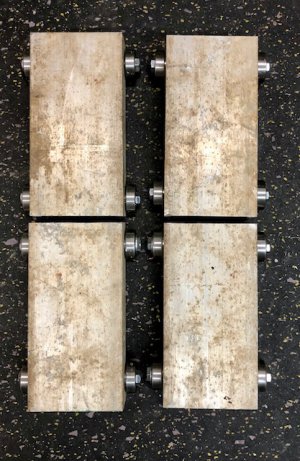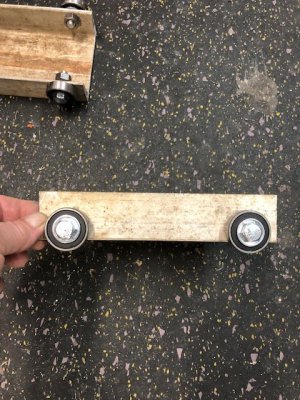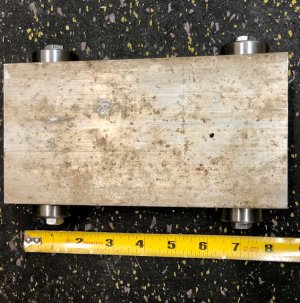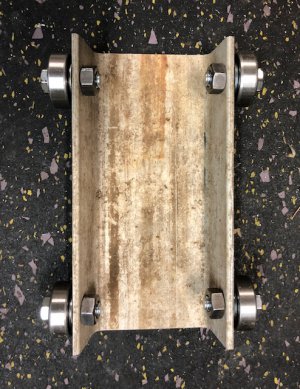- Joined
- Feb 2, 2013
- Messages
- 3,622
I have a lathe to move soon and i wanted to make the move as easy as possible.
i will have a forkilft on both the pick up and the shop ends to assist with the heavy lifting.
sliding it into place will be a bit easier without the bulk of the forklift on the long side.
the thought is to lower the lathe onto a set of skates and slide it into position and jack up the lathe to set it back down with the skates removed.
the lathe weighs in about 3500lbs.
i considered a few designs and came back with KISS in mind
so after 5 minutes of design, 5 minutes of calculation and 5 minutes of rounding up parts,
these is the abominations that i have created!
no they aren't pinewood derby rejects , but i could see the resemblance!
, but i could see the resemblance!




i had some 4" Aluminum channel that i whacked into 8" long pieces
i had some 6202 15mm bore to .380" bearings that would serve as the wheels, this meant that i needed to attach the wheels to the skates.
i did this by selecting 3/8x1-1/4" grade 5 bolts and turning 16) 14.9mm OD x .380" ID x 10mm long bushings to adapt the wheels to the attachment bolts.
i located and drilled 16) 3/8" holes in the skate bodies
i spaced the bearings from the skate body with 3/8" SAE washers (for their small OD), used HSS heavy nuts and locktite red to secure the nuts before i rattled them up tight.
total fab and assembly took about 2 hours.
each skate would easily hold and transport a safely estimated 1500 lbs
there is thought of adding a cleat to the end of each skate to prevent ejection , but still in consideration
as always relevant comments, questions, pointers are always welcomed and encouraged!
thanks for reading!
i will have a forkilft on both the pick up and the shop ends to assist with the heavy lifting.
sliding it into place will be a bit easier without the bulk of the forklift on the long side.
the thought is to lower the lathe onto a set of skates and slide it into position and jack up the lathe to set it back down with the skates removed.
the lathe weighs in about 3500lbs.
i considered a few designs and came back with KISS in mind
so after 5 minutes of design, 5 minutes of calculation and 5 minutes of rounding up parts,
these is the abominations that i have created!
no they aren't pinewood derby rejects
 , but i could see the resemblance!
, but i could see the resemblance! 



i had some 4" Aluminum channel that i whacked into 8" long pieces
i had some 6202 15mm bore to .380" bearings that would serve as the wheels, this meant that i needed to attach the wheels to the skates.
i did this by selecting 3/8x1-1/4" grade 5 bolts and turning 16) 14.9mm OD x .380" ID x 10mm long bushings to adapt the wheels to the attachment bolts.
i located and drilled 16) 3/8" holes in the skate bodies
i spaced the bearings from the skate body with 3/8" SAE washers (for their small OD), used HSS heavy nuts and locktite red to secure the nuts before i rattled them up tight.
total fab and assembly took about 2 hours.
each skate would easily hold and transport a safely estimated 1500 lbs
there is thought of adding a cleat to the end of each skate to prevent ejection , but still in consideration
as always relevant comments, questions, pointers are always welcomed and encouraged!
thanks for reading!


